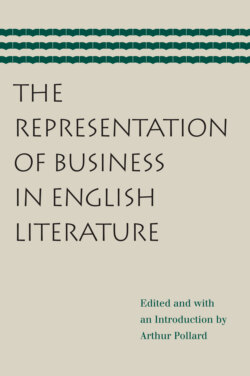Читать книгу The Representation of Business in English Literature - Группа авторов - Страница 15
На сайте Литреса книга снята с продажи.
THE FINANCIAL REVOLUTION—BRIBERY AND CORRUPTION
ОглавлениеThe debate over Luxury to some extent paralleled that provoked by the Financial Revolution. Those who criticised it tended to be critics of the Court, accusing the regime of exploiting demands for luxury goods in order to corrupt the people, while those who accepted it were more inclined to be Court supporters. Country writers blamed a corrupt aristocracy for conniving with the Court but were also suspicious of plutocrats in the City of London, whether they derived their wealth from stocks or overseas trade. Thus Pope castigated Sir Balaam in his Epistle to Bathurst. A “Citizen of sober fame,” he is tempted by the devil first by the theft of a diamond then by investments which yield profits “in one abundant show’r of Cent per Cent.” He sells himself to the prime minister, Sir Robert Walpole, by accepting a place at Court and his soul to the devil by accepting a bribe. Pope draws a contrast between corrupt merchants like Sir Balaam who sell out to the Court and independent merchants like the patriot Sir John Barnard who deplore the corruption of the times.
Sir Balaam’s final sell out is when he
Leaves the dull Cits, and joins (to please the fair)
The well-bred cuckolds in St. James’s air.
There were two quite distinct Londons in eighteenth-century literature. One was the City, the centre of business and commercial life, inhabited by tradesmen and merchants. The other was the Court end of town, frequented by the aristocracy and gentry who visited the capital for the season or even built town houses there in the new streets and squares north of Oxford Street. These represented two distinct sets of values. The City was generally praised as the habitat of frugal, respectable citizens who added to the nation’s wealth and well-being. For there was general agreement that England was a trading nation and that the business community contributed to the nation’s prosperity. In this respect it is significant that when John Bull, who became the nation’s symbol, made his first appearance he was not the bucolic farmer he later became but “the richest tradesman in all the country.”17 By contrast, the aristocrats who could afford town houses in London at the Court end of town were generally regarded as decadent. The West End was consequently decried as the scene of luxury and debauchery.
There were some critics of the City who represented merchants as being grasping and avaricious, having profit as their only motive and treating people as commodities. The type was a stock character on the stage. Sir Humphrey Staple, a merchant in a play by Leonard Welsted which appeared in 1727, deplored the representation of his kind in drama. He complains that
The wits and poets make it their business in their plays and prologues to abuse their betters, and that they treat persons of good reputation very injuriously, giving them nicknames such as Nikin, Gripe, Scrape-all, Split farthing and the like; Now Sir I must be plain to tell you that this licence is unreasonable, and that persons of substance and credit ought not to be libell’d by your poets and people of that character.18
Yet Staple himself deserves this reputation for his treatment of his daughter as an asset to be marketed on the marriage market. As he puts it: “my daughter is my merchandise, and I’ll not part with her upon credit; something for something and nothing for nothing, as I often say, is our family wisdom.” He is rebuked for treating his offspring as “a commodity to be disposed of” by another character who tells him “beauty is not the common merchandise, to be sold by cant and auction, or to be put up by inch of candle. That is for African slaves, not free born British ladies.”
Hogarth depicts another grasping merchant like Staple in the mercantile father who sells his daughter into wedlock with a noble lord’s son in Marriage à la mode. The merchant’s motive is pure greed, for his daughter’s marriage to the aristocratic rake is doomed from the start, as the image in the first plate of the two dogs chained together symbolises. His miserliness is also depicted in the final plate as he takes the wedding ring off his dead daughter’s finger. The unsuitability of a nouveau riche tradesman as a husband for the daughter of a well-established landed family is one of the reasons why the odious Solmes, a “prosperous upstart, mushroomed into rank,” is objectionable to Richardson’s Clarissa.
Despite these representations of the unacceptable face of business, there are signs that the image of merchants in literature was slowly improving during the early eighteenth century. Among poets, Edward Young wrote an ode in 1729 on British trade, “The Merchant.” This was a celebration of the role of commerce.19
Britain, fair daughter of the seas,
Is born for trade, to plough her field, the wave,
And reap the growth of every coast . . .
In drama the more favourable representation of merchants was largely due to the efforts of Whig dramatists like Sir Richard Steele and George Lillo. Sealand in Steele’s The Conscious Lovers (1723) is often seen as a turning point in the characterisation of the merchant, as he is eminently honest and upright. “We merchants are a species of gentry that have grown into the world this last century,” he declaims, “and are as honourable and almost as useful as you landed folks.” Though the disclaimer is ironic there is still a defensive view of commerce in The Conscious Lovers. It was not until the appearance of George Lillo’s The London Merchant in 1731 that a major production extolled the virtues of trade in its principal characters.
